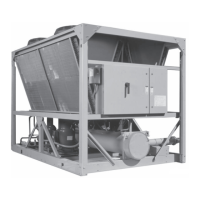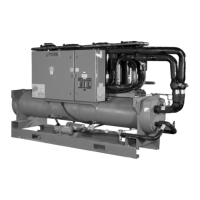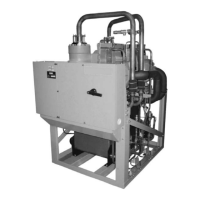JOHNSON CONTROLS
75
FORM 150.62-NM6 (103)
Whenever the motor protector or discharge sensor shuts
down a compressor and the system, the internal com-
pressor contacts will open for a period of 30 minutes to
assure that the motor or scroll temperatures have time
to dissipate the heat and cool down.
After 30 minutes, the contacts will close and the system
will be permitted to restart. The micro will not try to restart
the compressors in a system that shuts down on this
safety for a period of 30 minutes to allow the internal
compressor timer to time out.
When System Current Feedback option is selected
(Option 11 under OPTIONS Key Current Feedback),
this safety will operate as follows. If the actual voltage
of the system exceeds the programmed trip voltage for
5 seconds, the system will shutdown. This fault will not
be cleared until the condition is no longer present.
The Low Evaporator Temperature Cutout is to pro-
tect the evaporator from freeze-up with R-407C. This
safety uses the Cooler Inlet Refrigerant Temp Sensors
to monitor evaporator inlet refrigerant temperature on
each system. These sensors are only installed on
R-407C units. This safety is ignored for the rst 270
seconds of runtime.
In water cooling mode, if the refrigerant temperature falls
below 21°F, the system will be shut down.
In glycol cooling mode, if the refrigerant temp. is below
21°F and falls 19°F below the leaving chilled liquid temp.,
the system will shut down.
In either cooling mode, if the cooler inlet refrigerant
temp. sensor reads out of range low, the system will
also shut down.
The Low Superheat Cutout is to protect the compressor(s)
from liquid oodback due to low suction superheat. This
safety is only active when EEV is selected as the ex-
pansion valve in SERVICE Mode. This safety is ignored
for the rst 15 seconds of system runtime.
This cutout is ignored for the first 30 seconds of sys-
tem run time to avoid nuisance shutdowns, especially
on units that utilize a low pressure switch in place of the
suction pressure transducer.
After the rst 3 minutes, if the suction pressure falls
below the programmed cutout setting, a “transient
protection routine” is activated. This sets the cutout at
10% of the programmed value and ramps up the cutout
over the next 30 seconds. If at any time during this 30
seconds the suction pressure falls below the ramped
cutout, the system will stop. This transient protection
scheme only works if the suction pressure transducer
is installed. When using the mechanical LP switch, the
operating points of the LP switch are: opens at 23 PSIG
+/- 5 PSIG (1.59 barg +/- .34 barg), and closes at 35
PSIG +/- 5 PSIG (2.62 barg +/- .34 barg).
The Motor Protector/Mechanical High Pressure Cutout
protects the compressor motor from overheating or the
system from experiencing dangerously high discharge
pressure.
This fault condition is present when CR1 (SYS 1) or
CR2 (SYS 2) relays de-energize due to the HP switch
or motor protector opening. This causes the respective
CR contacts to open resulting in 0VDC to be applied on
the input to the microboard. The fault condition is cleared
when a 30VDC signal is restored to the input.
The internal motor protector opens at 185°F - 248°F
(85°C - 120°C) and auto resets. The mechanical HP
switch opens at 405 PSIG +/- 10 PSIG (27.92 barg +/-
.69 barg) and closes at 330 PSIG +/- 25 PSIG (22.75
barg +/- 1.72 barg).
The compressor is also equipped with a discharge tem-
perature sensor for the purpose of sensing internal scroll
temperature. This sensor protects the scrolls from over-
heating due to inadequate cooling that may occur when
refrigerant charge is low, or superheat is too high.
When the sensor senses a high temperature, it opens
the motor protector circuit in the compressor causing
the compressor to shut down.
During the rst two faults an MP/HP INHIBIT message
will be displayed and the system will not be locked out.
Only after the third fault will the MP/HP Fault message
shown below be displayed on the status display. Ad-
ditionally, the system will be locked out.
S Y S 1 M P / H P C O I N H I B
S Y S 2 M P / H P C O I N H I B
2
S Y S 1 H I G H M T R C U R R
S Y S 2 H I G H M T R C U R R
S Y S 1 L O W E V A P T E M P
S Y S 2 L O W E V A P T E M P
S Y S 1 L O W S U P E R H E A T
S Y S 2 L O W S U P E R H E A T
S Y S 1 M P / H P C O F A U L T
S Y S 2 M P / H P C O F A U L T

